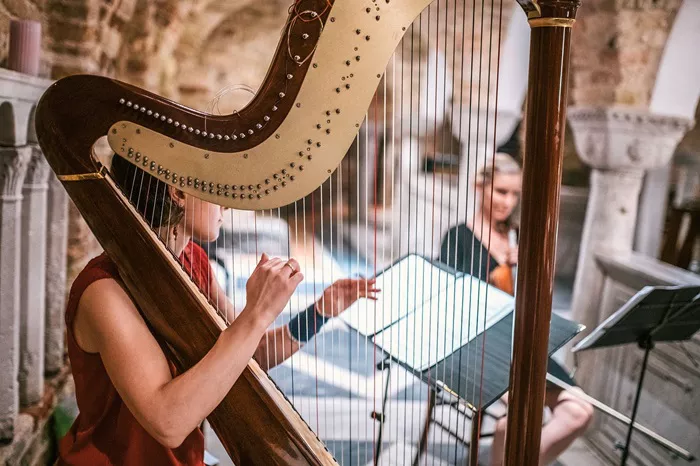Swans have long captivated the imagination of composers, inspiring some of the most poignant and majestic pieces in classical music. From the graceful ballets to introspective symphonies, the swan motif resonates through diverse compositions, each reflecting different facets of these elegant creatures. Let’s explore 6 classical works where swans soar through melodies, leaving a lasting imprint on musical history.
1. Camille Saint-Saëns – The Carnival of the Animals: The Swan
Camille Saint-Saëns’ “The Carnival of the Animals” is a whimsical menagerie of musical portraits, each capturing the essence of its subject with humor and charm. Among these, “The Swan” stands out as a serene and lyrical portrayal of grace. Written for solo cello and accompanied by gentle piano, the piece evokes the image of a swan gliding across a tranquil lake. Its simplicity and elegance have made it a favorite in both concert halls and intimate settings, showcasing Saint-Saëns’ mastery in creating evocative miniatures.
2. Pyotr Ilyich Tchaikovsky – Swan Lake: Suite, Op. 20
Arguably the most iconic work associated with swans, Tchaikovsky’s “Swan Lake” epitomizes the allure and tragedy of these birds through music and dance. Originally composed as a ballet in 1875-76, the suite version distills the essence of the story into a symphonic masterpiece. The “Swan Theme” from Act II is particularly renowned, with its haunting melody performed by the cellos, depicting the enchanted swan maidens under the spell of the evil sorcerer Rothbart. Tchaikovsky’s ability to convey both the ethereal beauty and the underlying pathos of the swan motif has ensured “Swan Lake” a place as one of the most beloved and enduring works in the classical repertoire.
3. Maurice Ravel – Ma mère l’Oye (Mother Goose Suite): Laideronnette, Empress of the Pagodas
In his suite “Ma mère l’Oye,” Maurice Ravel weaves a tapestry of fairy tales into music, creating a magical world where swans and other mythical creatures come to life. In “Laideronnette, Empress of the Pagodas,” Ravel introduces a shimmering and exotic portrayal of a princess in a pagoda surrounded by enchanted swans. The music unfolds with delicate orchestration and evocative harmonies, transporting listeners to a realm where imagination reigns supreme. Ravel’s ability to evoke wonder and fantasy through his music makes this piece a captivating exploration of the swan motif in a whimsical setting.
4. Sergei Rachmaninoff – Symphony No. 2 in E Minor, Op. 27
Sergei Rachmaninoff’s Symphony No. 2 is a lush and emotive work that delves into the depths of human emotion, often likened to a swan’s graceful yet powerful movements. The symphony’s lyrical themes and expansive orchestration resonate with a sense of yearning and passion, reflecting Rachmaninoff’s own struggles and triumphs. The second movement, in particular, has been noted for its swan-like qualities, where the melody soars and arcs with a poignant beauty reminiscent of the bird’s flight. Rachmaninoff’s Symphony No. 2 stands as a testament to the enduring allure of the swan motif in capturing profound and introspective musical landscapes.
5. Benjamin Britten – The Young Person’s Guide to the Orchestra: Fugue
Benjamin Britten’s “The Young Person’s Guide to the Orchestra” serves as both an educational tool and a showcase of orchestral brilliance. In the fugue section, Britten pays homage to Henry Purcell’s theme, ingeniously weaving it through various sections of the orchestra. The fugue culminates in a majestic and triumphant finale, where the theme is restated with full orchestral force, akin to a swan’s powerful takeoff into flight. Britten’s skillful orchestration and inventive use of themes highlight the swan’s symbolism of unity and strength, making this piece a testament to the versatility of the swan motif in orchestral music.
6. Igor Stravinsky – The Firebird: Finale
Igor Stravinsky’s ballet “The Firebird” concludes with a dazzling finale that incorporates the swan motif in a dramatic and transformative way. As the Firebird’s magic restores order and harmony to the kingdom, Stravinsky employs shimmering orchestration and soaring melodies that evoke the image of swans in flight. The finale builds to a majestic climax, where the swan motif is imbued with a sense of triumph and renewal, symbolizing the ballet’s theme of transformation and rebirth. Stravinsky’s innovative use of rhythm and color in “The Firebird” showcases the swan motif as a symbol of transcendence and hope, leaving a lasting impression on audiences.
See Also: The Power of Classical Music: How It Benefits the Brain
Conclusion:
In conclusion, swans have inspired composers across centuries to create music that embodies their grace, beauty, and symbolism. From Saint-Saëns’ lyrical cello solo to Tchaikovsky’s poignant ballet, and from Ravel’s fantastical imagery to Stravinsky’s dramatic finale, each composer has interpreted the swan motif in unique and compelling ways. These six classical works stand as testament to the enduring allure of swans in music, capturing their essence through melodies that soar and stories that resonate across time and culture.

